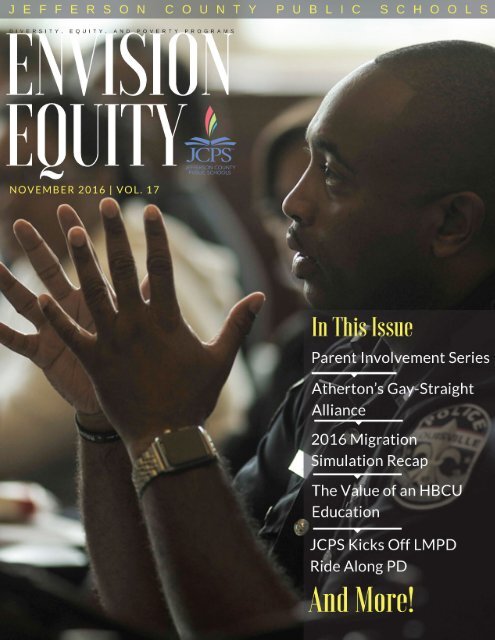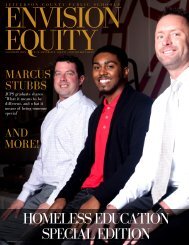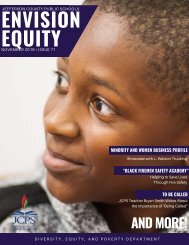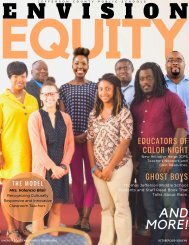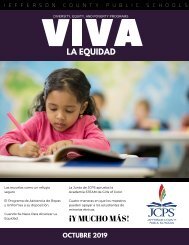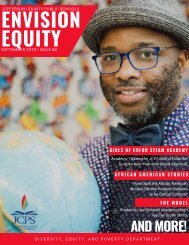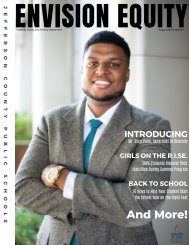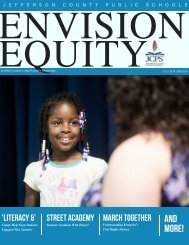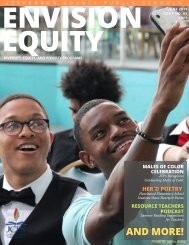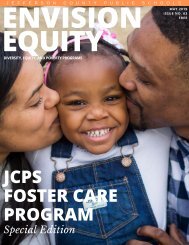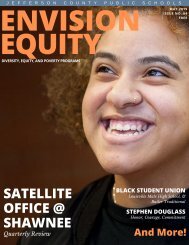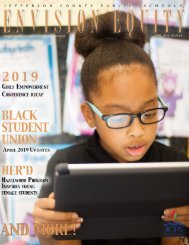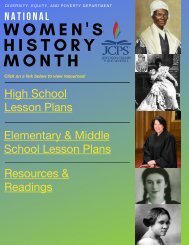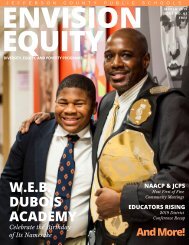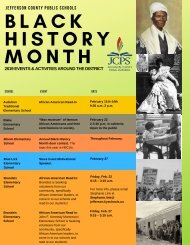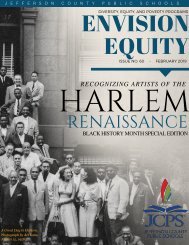Envision Equity - November 16 Edition
Create successful ePaper yourself
Turn your PDF publications into a flip-book with our unique Google optimized e-Paper software.
1
<strong>Envision</strong> <strong>Equity</strong><br />
NOVEMBER 20<strong>16</strong><br />
Life of a Muslim Student PD Encourages Valuable<br />
Discourse Among Educators<br />
By Dr. Monica Lakhwani—Specialist, Diversity, <strong>Equity</strong>, and Poverty Programs<br />
Above, Lassister Middle School teacher Jemilla Barakaat facilitates a<br />
breakout session during the Life of a Muslim Student PD.<br />
The Voices Series was designed to create<br />
awareness and help educators connect with<br />
current issues that our students may be facing.<br />
As part of this series, Life as a Muslim Student was<br />
designed to bring about awareness of the cultural<br />
feelings and experiences of Muslim students in an effort<br />
to help improve their outcomes.<br />
Above, Tytianna N.M. Wells Smith facilitates a breakout session<br />
during the Life of a Muslim Student PD.<br />
Life as a Muslim<br />
Student took place<br />
on October 6 at<br />
Newburg Middle<br />
School. Participants<br />
had a chance to hear<br />
students voice<br />
concerns facing<br />
them currently and<br />
then were lead into<br />
round-robin discussions. The audio segments were<br />
aligned with questions to generate not only discussion<br />
but also systems of support. Participants in this session<br />
focused on the following:<br />
• Misconceptions that non-Muslim peers may<br />
have about Muslim students and ways of<br />
educating youth about them<br />
• Obstacles or challenges that Muslim students<br />
and/or their families face both in school and<br />
outside of school and what support can be<br />
provided to help them overcome these<br />
challenges<br />
• Specific resources educators need—and/or are<br />
aware of—in working with students/families<br />
Photos, Abdul Sharif<br />
Rajaa Ammor is a bilingual associate instructor at<br />
Hazelwood Elementary and helped co-facilitate the<br />
session. Ms. Ammor shared, “The audio voices from<br />
those students brought alive testimonies of the<br />
misconceptions about students’ culture, faith, language,<br />
and whole life. Teachers and schools play a huge role in<br />
preparing students for the real world. They can do this<br />
by teaching tolerance and demonstrating it, accepting<br />
perspectives, and creating a warm environment where<br />
all students feel loved and accepted. Classroom<br />
discussions should be structured to help students<br />
grapple with current events and conflicting viewpoints<br />
in constructive ways and not in ways of targeting<br />
students of particular faith or culture.”<br />
If you missed the session in October and would like to<br />
learn more, Muslim Student Voices: Building<br />
Understanding will take place on <strong>November</strong> 10 at<br />
Metro United Way. During this session, participants will<br />
hear from a panel of Muslim students (some former<br />
JCPS students) who will share their experiences and<br />
challenges as well as provide an opportunity to ask<br />
questions. For those who are interested, sign up via<br />
pdCentral <strong>16</strong>-1780672: Muslim Student Voices: Building<br />
Understanding.<br />
“This PD was very enlightening, and allowed educators<br />
to put themselves in the shoes of Muslim students, and<br />
attempt to acknowledge, prepare for, and teach this<br />
growing population within JCPS.”<br />
-Matt Trzaskus, Teacher, Seneca High<br />
2
<strong>Envision</strong> <strong>Equity</strong><br />
NOVEMBER 20<strong>16</strong><br />
Photo, Google Images.<br />
Above, parents listen to a presenter at the first Parent Involvement Series held at Rangeland Elementary School.<br />
Photos, Abdul Sharif<br />
20<strong>16</strong>-17 Parent Involvement Series<br />
By Dr. John D. Marshall—JCPS Chief <strong>Equity</strong> Officer<br />
The first Parent Involvement Series was a success.<br />
It was held at Rangeland Elementary School, and<br />
22 parents attended. The parents were energetic,<br />
inquisitive, concerned, and receptive. Jefferson County<br />
Public Schools (JCPS) is dedicated to engaging families<br />
and making sure that they have the tools they need to<br />
navigate through this massive organization.<br />
Dr. Taul, an administrator from Moore Traditional School,<br />
was poised and ready to give the parents everything they<br />
needed. The first topic was engagement, and Dr. Taul and<br />
guest speakers shared personal experiences (some good,<br />
some not so good) of parenting and working with<br />
teachers/schools. In turn, the parents shared their stories,<br />
and the discourse was heartfelt.<br />
Above, a parent reads information during the Parent Involvement<br />
Series at Rangeland Elementary.<br />
help her own child, she saw a need to advocate<br />
for another child as well. In addition, a parent<br />
asked pointed questions about parent-teacher<br />
One of the most<br />
moving parts of the<br />
night was a parent<br />
who asked how<br />
she can advocate<br />
for a child who is<br />
not hers. Although<br />
she admitted to<br />
struggling with<br />
understanding all<br />
she needed to<br />
know in order to<br />
conferences and how to enroll her child in before- and<br />
after-school activities. She received the answer she<br />
needed and has already set up a meeting to enroll her<br />
child in enrichment opportunities that will enhance the<br />
child's learning.<br />
In each session,<br />
Dr. Taul will base<br />
her topic on our<br />
well-known First<br />
Task Is to Ask<br />
sheets. You can<br />
see all of the First<br />
Task Is to Ask<br />
sheets here.<br />
Please feel free to<br />
use them yourself<br />
and with school staff.<br />
Above, Moore Traditional Assistant Principal, Dr. Toetta Taul<br />
presents information to parents.<br />
We must get more parents involved! There's absolutely no<br />
way around it. The research clearly shows that if we align,<br />
engage, and inform our parents, student outcomes will<br />
improve. The Parent Involvement Series seeks to do just<br />
that. Please join us for the next topic. You will leave with<br />
great information and navigation tools. (Food and<br />
childcare are provided.)<br />
Click here to download a Parent Involvement Series flier.<br />
3
<strong>Envision</strong> <strong>Equity</strong><br />
NOVEMBER 20<strong>16</strong><br />
Helping Kids Cope With Grief<br />
Nine ways to help a child who has lost a loved one.<br />
By Marie Bradby—Today’s Woman Now<br />
“<br />
When I tell people that I provide grief and loss<br />
counseling for children, they say, ‘How terrible.’ It’s<br />
not terrible at all. I come and talk to them during a<br />
difficult time in their lives,” says Candice Evans, a<br />
licensed clinical social worker and school-based grief<br />
counselor with Hosparus in Louisville.<br />
Candice uses puppets as part of the group sessions she has with<br />
the students. Photos by Melissa Donald<br />
“The students<br />
come together with<br />
their peers and<br />
share their stories<br />
of loss and what<br />
happened to the<br />
person who died.<br />
They learn about<br />
physical and<br />
emotional grief.<br />
They learn that it’s<br />
not all sad; they<br />
can be happy,<br />
especially when<br />
they have great<br />
memories about<br />
the person. They<br />
learn that people<br />
die for physical<br />
reasons. Grandma<br />
died of cancer and the doctors couldn’t help her any<br />
more. They are able to express their feelings and learn<br />
healthy coping skills (breathing exercises,<br />
mindfulness).”<br />
Candice, 31, for a long time knew she would work with<br />
people; she shadowed a social worker in high school.<br />
In college, she took a course on death and dying and<br />
thought, “I’m okay with this.” She completed an<br />
internship at a hospice center in St. Louis and took a<br />
job working with families with individuals facing the<br />
end of life.<br />
“I thought it would be difficult for me to sit with<br />
families and not cry. I quickly learned that this work is<br />
good for me. I did a lot of growing up. Most of my<br />
clients were much older than me. I drew my strength<br />
from them, watching them face death with courage<br />
and grace at this fragile time in life.<br />
“I think the greatest gift and job responsibility was<br />
being able to sit with people. It’s more difficult than it<br />
sounds. They are in emotional distress and don’t know<br />
when the end will come. I offer listening and support in<br />
a nonjudgmental presence.”<br />
After marrying and moving to Louisville in 2008 to get<br />
her master’s degree at the Kent School of Social Work<br />
at the University of Louisville, Candice began working<br />
at Hosparus in Louisville and eventually took over the<br />
school-based “Grief Relief” program for children.<br />
Because of donations, Hosparus is able to provide<br />
schools six weeks of counseling, one hour a week, for<br />
groups of five to eight kids.<br />
“I ask the kids: Is it a choice to grieve? They say, ‘Yes,<br />
it is.’ But it isn’t. If you have a significant loss, you will<br />
grieve that loss. They can look like a normal kid, but<br />
they can also be sad and angry because their person<br />
died. It’s normal to allow yourself to feel.<br />
“We open up group with saying your name, who died,<br />
and how you feel about coming to group today. They<br />
mostly say they are happy to come to group...<br />
because they have some place to come talk about it.”<br />
(Left) For the first therapy session, group members play Thumb Ball which<br />
requires a ball to be tossed from one person to another. After catching it,<br />
the member must read the question on the ball out loud and answer it.<br />
The counseling<br />
that Candice<br />
and other staff<br />
provide is<br />
developmental.<br />
For children<br />
ages 4-7,<br />
death is seen<br />
Continued on next page.<br />
4
<strong>Envision</strong> <strong>Equity</strong><br />
NOVEMBER 20<strong>16</strong><br />
as reversible.<br />
They often may<br />
feel responsible<br />
for the death<br />
because of<br />
thoughts or<br />
wishes. They<br />
may not<br />
understand that<br />
grandma died<br />
because of a<br />
heart attack and<br />
instead may<br />
think she died<br />
because “I said<br />
some angry<br />
things.” They<br />
can have<br />
repetitive<br />
questions about<br />
the death — how<br />
Candice starts her sessions with the talking stick as a way of helping<br />
children feel more comfortable and secure as they share memories of<br />
their loved one.<br />
and why. Grief responses may include regression,<br />
sleeping and eating disturbances, and nightmares.<br />
Children ages 7-11 see death as a punishment — for<br />
not being good or not doing something. They want<br />
details and might wonder, is something going to<br />
happen to Dad now that Mom has died? Grief<br />
responses may include regression, acting out,<br />
problems in school, sleep and eating disruption, and a<br />
desire to join the person who died.<br />
(L-R) The children make memory voltives to honor their loved one; Candice<br />
creates a thumb print. Before the relative dies, the child can make a thumb print of<br />
the person's thumb using a piece of sculpting clay. Candice bakes the piece of clay<br />
and gives it to the child after it hardens.<br />
Children<br />
12-18, have<br />
a more adult<br />
response:<br />
extreme<br />
sadness,<br />
regression,<br />
denial,<br />
anger,<br />
depression,<br />
and<br />
loneliness. They try to make sense of the death. There<br />
might be acting out, risk-taking, and seeking support<br />
through peers versus family.<br />
Here are Candice’s survival skills on helping children<br />
cope with grief and loss:<br />
Help children understand the four basic concepts of<br />
death so they can fully grieve and better understand<br />
what happened.<br />
1. Death is irreversible. In movies, games,<br />
and television shows, characters “die”<br />
and come back to life. It’s important that<br />
children know that death is permanent.<br />
2. All life functions end completely at the<br />
time of death. Children may be<br />
concerned about whether or not the<br />
person who died can feel or think. It<br />
might comfort them to know that when a<br />
person dies, they cannot move, breathe,<br />
think, or feel.<br />
3. Everything that is alive eventually<br />
dies. Children, just as adults, struggle<br />
with the concept of death. Help children<br />
to understand that dying is a part of life<br />
for all living things, including plants,<br />
animals, insects, and people.<br />
4. There are physical reasons why<br />
someone dies. Children who are not<br />
told how the person died may come up<br />
with their own explanation, which can<br />
cause guilt or shame.<br />
5. Use concrete words to explain death<br />
to children. Adults often use phrases<br />
like “went to sleep” and “resting” to<br />
avoid frightening children. Use the words<br />
“died” and “dead” to avoid confusion. A<br />
child who is told the person is “sleeping”<br />
may become afraid to go to sleep, or<br />
they might watch the surviving parent as<br />
they sleep to make sure he or she<br />
doesn’t die.<br />
6. Provide support over time. Not all<br />
children who have experienced a loss<br />
due to death need counseling, but all<br />
children who have experienced a loss<br />
due to death can benefit from education<br />
and a lifetime of support.<br />
7. Demonstrate grieving by letting<br />
children see you cry, talking about the<br />
person who died, and seeking support.<br />
8. Allow younger children to express<br />
themselves through normal play,<br />
drawing, looking at pictures. Younger<br />
and older children may benefit from<br />
being with peers and receiving support<br />
in a group setting.<br />
9. Help children preserve<br />
memories (create a memory book) and<br />
create new ones through sharing of<br />
memories or rituals, such as lighting a<br />
candle in memory of the person who<br />
died.<br />
Have you had to help your child through the grieving<br />
process? How did you do it?
<strong>Envision</strong> <strong>Equity</strong><br />
NOVEMBER 20<strong>16</strong><br />
Photo, google images<br />
Standardized tests: A Dilemma for African<br />
Americans<br />
By Linda Joy Johnson—Wayne State University<br />
Years of being a classroom instructor and an<br />
educational administrator has afforded this<br />
African American a specific vantage point on the<br />
matters of education in America.<br />
A Profile of Standardized Tests<br />
Public education might be the last resort for children of<br />
color to constructively assimilate into American society,<br />
but there is an enormous disjoint looming over America’s<br />
educational itinerary with dire consequences for African<br />
Americans. Across America our government spends less<br />
educational funding on students of color. Ary Spatig-<br />
Amerikaner (2012) painstakingly provides the convoluted<br />
details on how the unequal funding is maintained through<br />
Federal loopholes. While schools today are<br />
overwhelmingly depending on standardized tests in<br />
reading and mathematics, the connection between testing<br />
and funding is an unrefined area of contention.<br />
The results of standardized tests appears to be the most<br />
important attribute of a school’s worthiness. Schools use<br />
standardized tests to measure a student’s ability, while<br />
ignoring other salient indicators. Far too often the tests<br />
scores do not show the real potential of African American<br />
students. Because standardized tests results are used to<br />
determine how funding will be allocated to schools, lowincome<br />
districts face even more pressure to have their<br />
students earn high scores on such tests. In addition, the<br />
tests are also used for tracking and student placement.<br />
One year ago 11 former Atlanta educators were convicted<br />
of conspiring to tamper with thousands of students’ test<br />
scores. The cheating scandal has grown to symbolize the<br />
ills of America’s emphasis on standardized testing. Tell<br />
teachers their salaries are tied to test scores and things<br />
change. Deceptive scoring practices can be found in<br />
schools across the country, and they seem to be growing<br />
in popularity in an era that places heavy emphasis on<br />
standardized testing (EDUCATION, 20<strong>16</strong>).<br />
In a message published in the February 2014 issue of<br />
Chicago Union Teacher magazine, then CTU President<br />
Karen G J Lewis wrote: “…we have to be clear about the<br />
original purpose of standardized tests…” The use of<br />
standardized tests has its origins in the Eugenics<br />
movement. The Eugenics movement hypothesized that<br />
certain races were inferior to others biologically and<br />
intellectually. The original IQ tests were designed by<br />
French psychologist Alfred Binet for benign and limited<br />
uses on young children who were not developing<br />
“normally” as “general” tools to make “general” decisions,<br />
not a precise measurement for precise decisions to signal<br />
when a child needed more help in their intellectual<br />
development.<br />
Continued on next page.
<strong>Envision</strong> <strong>Equity</strong><br />
NOVEMBER 20<strong>16</strong><br />
and makes them more likely to drop out later on (U.S. News,<br />
20<strong>16</strong>).<br />
Photo, google images<br />
According to the Racial Justice and Standardized<br />
Educational Testing program, the law promotes teaching to<br />
the mostly multiple-choice state tests, focusing on rote skills<br />
and ignoring higher-level thinking. The impact is greater in<br />
schools that serve low-income youth, particularly students of<br />
color. Likewise, The National Center for Fair & Open Testing<br />
criticized standardized tests as incredibly inefficient while<br />
unfairly misplacing black boys in special education classes.<br />
Many times these young African Americans are not in need<br />
of special education but lack the knowledge about the<br />
standardized educational canons that the tests are built on.<br />
The Standards of Dominance<br />
Standardized tests support a white middle class mode of<br />
ranking. The policies, practices, processes, and rituals of<br />
American education are implemented by the privilege group,<br />
thereby maintaining a disprivilege group (Goodman, 2012).<br />
Bill Gates is a very strong proponent and financial supporter<br />
of standardized testing. His money speaks volumes.<br />
Alfred Tatum expounds on the idea of black alienation in<br />
education by agreeing that the dominant culture sees their<br />
own race widely represented on TV; when they do not have<br />
to educate their children about systemic racism in schools;<br />
when they are sure that the low performance of their child is<br />
not due to his race, and the dominate group can dictate if an<br />
issue is “racial” because of their perceived credibility.<br />
On a daily basis African American children leave their<br />
“cultural selves” to assimilate into a European centered<br />
model of learning. (Ladson-Billlings, 1998, p. 219). The black<br />
child soon learns that he or she is not speaking Standard<br />
English, as well as learning that their cultural experiences are<br />
not the norm of the larger society. Paulo Freire, former<br />
Professor of History and Philosophy of Education, would<br />
describe the latter as the Pedagogy of the Oppressed which<br />
tends to devalue or exclude experiences of African<br />
Americans, thus representing African American culture as<br />
inferior. Children’s books also may not be as interesting to<br />
black children (or their parents) because of the lack of<br />
diversity in them: Characters in children’s books are<br />
overwhelmingly white. Black students are more likely to be<br />
held back, despite mounting research showing that holding<br />
back children does not benefit them socially or academically<br />
The combination of institutional racism, intergenerational<br />
poverty, and the lack of meaningfully sustained educational<br />
reform creates challenges for schools and students.<br />
Measurement experts agree that no test is good enough to<br />
serve as the sole or primary basis for tracking or holding<br />
students back. Too often the assumption is that low-scoring<br />
students need low-level remediation rather than enrichment,<br />
positive challenges, and support, according to The National<br />
Center for Fair and Open Testing. Today, as an<br />
acknowledgment of the inherent racial and economic<br />
inequity of standardized achievement tests, hundreds of<br />
colleges have already stopped requiring the SAT for college<br />
admission decisions: But the same cannot be said for k –<br />
12 th grades.<br />
Various educational researchers have always maintained that<br />
standardized tests ultimately measure a student’s access to<br />
resources. Test scores reflect the advantages and resources<br />
that wealthier children have; among these advantages are<br />
private tutoring and monetary funds to access testpreparatory<br />
classes. Attaching high stakes to these exams<br />
only serves to exacerbate racial and class inequality. Boston<br />
University economics professors Olesya Baker and Kevin<br />
Lang’s 2013 study, “The School to Prison Pipeline Exposed,”<br />
reveals that a standardized bubble test does not help<br />
teachers understand how a student arrived at answer choice<br />
“C.” In A Brief History of the "Testocracy," Standardized<br />
Testing and Test-Defying, Jesse Hgopian (2015) states that<br />
tests that measure as little and as poorly as multiple-choice<br />
exams cannot provide meaningful accountability.<br />
The Writer’s Perspective<br />
While administering a student exchange program between<br />
the University of Salford in Manchester England and a<br />
premier university in the United States, a troubling truth<br />
about multiple choice (or bubble tests) reaffirmed this writer’s<br />
misgivings regarding standardized testing formats. The<br />
students from England were very high academic achievers<br />
and were required to maintain a certain grade point average<br />
in order to remain in the exchange program.<br />
The<br />
students<br />
were<br />
quite<br />
dejected<br />
after<br />
taking<br />
their first<br />
multiple<br />
choice<br />
test.<br />
They<br />
Photo, google images<br />
were use<br />
to a test<br />
taking strategy wherein a written discourse supporting or<br />
rejecting a certain argument was required. They expressed<br />
Continued on next page.
their dissatisfaction about having to select only one answer<br />
out of four questions and not being afforded a chance to<br />
defend their answer, or debate the fallacies of the other<br />
answers. The exchange students had been taught to think<br />
abstractly, to engage their higher order thinking skills, and<br />
to discern a matter before making one linear assumption.<br />
Too often test preparation replaces more in-depth and<br />
comprehensive instruction, causing students to receive an<br />
inferior education. A few decades ago I was hired as a high<br />
school English teacher in the City of Detroit. After being<br />
shown a store room full of neatly stacked classroom texts,<br />
the instructions from the administration were to issue the<br />
books accordingly but not to assign homework from them,<br />
but rather teach specific test content for the upcoming citywide<br />
standardized testing. The day after Labor Day will<br />
mark the fall 20<strong>16</strong> semester for many districts and the<br />
practice of teaching to the test will once again take center<br />
stage.<br />
Stewart, D. L. (2008). Being all of me: Black Students<br />
negotiating multiple identities. Journal of Higher Education.<br />
Swanson, D. P., Cunningham, M., & Spencer, M. B. (2003).<br />
Black males’ structural<br />
Conditions, achievement patterns, normative needs, and<br />
“opportunities.” Urban<br />
Education, 38, 608-633.<br />
Young, Alford A, Jr. (2004). The Minds of Marginalized Black<br />
Men: Making Sense of Mobility, Opportunity, and Future<br />
Life Chances. Princeton, New Jersey: Princeton University<br />
Press.<br />
http://www.rethinkingschools.org/archive/<br />
29_03/29-3_peterson_berlak.shtml<br />
http://www.theatlantic.com/education/archive/20<strong>16</strong>/04/whyteachers-cheat/480039/<br />
http://www.usnews.com/news/articles/20<strong>16</strong>-06-01/title-i-richschool-districts-get-millions-in-federal-money-meant-forpoor-kids<br />
Photo, google images<br />
In the journal of Rethinking Schools, the late educator for<br />
educational justice, Harold Berlak, maintained that “…<br />
standardized curriculum and tests insist upon one set of<br />
answers, and only one. Linking standards and curriculum to<br />
high-stakes testing is a powerful and pervasive way to<br />
ensure the continued hegemony of the dominant culture.<br />
The standards and tests by design [create] a particular and<br />
singular view of the "basics" of history, geography,<br />
literature, art, and ways of looking at and thinking about<br />
truth. They are an effort to put an end to the most valuable<br />
asset of a multicultural society”.<br />
References<br />
Fergus, E., Noguera, P., & Martin, M. (2014). Schooling for<br />
resilience: Improving<br />
The life trajectory of Black and Latino boys. Cambridge,<br />
MA: Harvard Education<br />
Press.<br />
Goodman, K. F. (2012). Privilege and Disprivilege in<br />
Discourse in and Around Literacy Assessment in Second<br />
Grade. (Doctoral dissertation). Retrieved from http://<br />
scholarcommons.sc.edu/etd/1510<br />
Ladson-Billings, G., & Tate, W.F. (1995). Toward a critical<br />
race theory in education. Teachers College Record, 97(1),<br />
pp. 47 – 68.
<strong>Envision</strong> <strong>Equity</strong><br />
NOVEMBER 20<strong>16</strong><br />
Above, JCPS Staff and LMPD Officers attend the Ride Along PD.<br />
Photos, Abdul Sharif<br />
JCPS Teachers Ride Along With LMPD Officers During<br />
Innovative PD<br />
By Abdul Sharif—Diversity, <strong>Equity</strong>, and Poverty Programs<br />
On September 30, 20<strong>16</strong>, the office of Diversity, <strong>Equity</strong>,<br />
and Poverty (DEP) Programs kicked off a unique<br />
professional-development (PD) session that is<br />
designed to strengthen the relationships between Jefferson<br />
County Public Schools (JCPS) staff and Louisville Metro<br />
Police Department (LMPD) School Resource Officers (SROs)<br />
and to inform the staff members about homelessness among<br />
JCPS students.<br />
"It was nice to be in the PD and hear the LMPD School<br />
Resource Officer’s point of view on some of the topics," said<br />
Nora Wood, a fifth-grade teacher at Auburndale Elementary<br />
School. "During the ride-along portion of the PD, we got to<br />
see some of the neighborhoods that our students are coming<br />
from."<br />
Wood is 1 of nearly 30 teachers who rode along<br />
with LMPD SROs to learn more about the various<br />
neighborhoods their students come from and the many<br />
challenges they may face.<br />
"I chose to attend the ride-along PD because I’ve always<br />
been interested in being a police officer," said Brittany Frills,<br />
an Exceptional Child Education (ECE) instructional assistant<br />
at Dawson Orman Education Center. Frills stated that she<br />
believes all JCPS staff should attend this PD not only to learn<br />
about SROs but also to learn about the needs of homeless<br />
students in the district.<br />
"It’s a very innovative way of providing support for our<br />
teachers and our staff. Basically, it came from the idea that<br />
we have to educate the whole student. We have teachers and<br />
staff working in direct contact with students and helping them<br />
with their education; they need to understand where our<br />
students are coming from. They need to understand their<br />
community—the barriers that they face. They also need to<br />
understand that there is value in every single community,"<br />
said Giselle Danger, coordinator for Homeless Education<br />
at JCPS.<br />
Tempe Douglas, an instructional assistant in Special Needs at<br />
Dawson Orman, said that the PD helped change her<br />
perception of police officers. “I am a mother. I have a 33-yearold<br />
son,” said Douglas. “Not all police officers are bad. They<br />
have to have strategies to deal with the situations they’re in,<br />
and at the end of the day, they want to go home just like<br />
everyone else.”<br />
Click here to watch a video interview of PD participants.<br />
Click here for a flier with future ride-along PD dates.
<strong>Envision</strong> <strong>Equity</strong><br />
NOVEMBER 20<strong>16</strong><br />
Atherton’s Gay-Straight Alliance<br />
By Tony Prince–English Teacher, Atherton High School<br />
Ihave been sponsoring Gay-Straight Alliances (GSA)<br />
in Jefferson County Public Schools for over 20<br />
years now. At Atherton, where I teach, we now call<br />
our GSA a “Gender-Sexuality Alliance” to be more<br />
inclusive of all genders and sexualities. I’ve been reflecting<br />
a lot lately about how much has changed over the last<br />
couple of decades in terms of the multiplicity of ways in<br />
which people, especially young people, are labeling and<br />
identifying themselves. On the one<br />
hand, it seems to me that all of these<br />
labels reflect an increasing awareness<br />
and understanding of the complexity<br />
and diversity of humanity in terms of<br />
gender and sexuality, which I think is a<br />
very healthy thing. However, every<br />
once and a while I begin to wonder if<br />
more and more labels and distinctions<br />
don’t sometimes cause us to overemphasize<br />
our differences and create<br />
more barriers between us instead of<br />
fostering a greater understanding and<br />
acceptance of ourselves and each<br />
other, which I think is their intended<br />
goal.<br />
For example, last year a student came<br />
out to her father as “pansexual.” It<br />
took a while for her to explain the term<br />
to her father and to persuade him to Tony Price<br />
accept this as her sexual identity. A<br />
few months later, she realized that the<br />
label “bisexual” really defined her attractions more<br />
accurately and she was discussing this realization with<br />
great distress at a GSA meeting. While she was explaining<br />
her situation, she began to cry. She was not only worried<br />
about having to again come out to her father, she was<br />
also concerned about rejection by her group of pansexual<br />
friends whom she felt might think that she “had been<br />
fake” with them. At that moment, it became clear to me<br />
that more and more complex and nuanced identity labels<br />
may not always be a way towards greater understanding<br />
of ourselves and others but instead can sometimes create<br />
unnecessary and anxiety-producing divisions and<br />
distinctions between us.<br />
At another GSA meeting, a student was very angry<br />
because people kept using the pronouns “she” and “her”<br />
instead of “they” and “them” which this student felt better<br />
suited their gender identity. While I respected this<br />
student’s personal wishes and understand that some<br />
people are more ambiguously gendered or more genderfluid<br />
than others, I was troubled by how angry this young<br />
person was about what sounded from their description of<br />
these events like slips-of-the-tongue by people who<br />
haven’t yet gotten used to the idea of a single person<br />
making reference to themselves using what have<br />
traditionally been plural pronouns, rather than intentional<br />
refusals to comply with their<br />
requests.<br />
A few years ago my husband and I<br />
started a theatre company, The<br />
Liminal Playhouse, with the following<br />
mission statement: “The Liminal<br />
Playhouse embraces, explores and<br />
celebrates the ambiguous, and<br />
sometimes paradoxical, nature of<br />
our shared humanity.” I think we are<br />
all more complex than any of the<br />
labels we, or others, may pin on us;<br />
and as we continue to (hopefully)<br />
move beyond simplistic binaries<br />
(male/female, black/white, gay/<br />
straight) to define ourselves, my<br />
hope is that we move towards a<br />
greater love and appreciation of the<br />
complexity inherent in being human<br />
and that we don’t find ourselves<br />
trapped in an ever-increasing<br />
labyrinth of labels that may have the<br />
unintended consequence of creating more divisions<br />
between us and less emphasis on our shared humanity.
<strong>Envision</strong> <strong>Equity</strong><br />
NOVEMBER 20<strong>16</strong><br />
The Value of an HBCU Education<br />
By Dionne Griffiths, M.A.<br />
Many high school seniors are preparing to apply to college<br />
and it is a good time for younger high school students to<br />
think about higher education as well. Last spring, I spoke<br />
to 140 African American high school students and their<br />
parents during a historically black colleges and universities (HBCU)<br />
tour pre-departure orientation session. My alma mater, Spelman<br />
College, was one of the institutions on their list. I was eager to share<br />
with them my experiences at Spelman, inform them of the priceless<br />
value of an HBCU education, and give them insight on funding<br />
resources.<br />
I let the attendees know that I<br />
chose my college because I<br />
knew that Spelman was an<br />
institution that was invested<br />
in the holistic education and<br />
development of young black<br />
women since 1881. It is a<br />
nurturing environment that is<br />
Photo, google images<br />
also academically rigorous. It<br />
is a place that supports and uplifts women of African descent through<br />
student-professor engagement, the dynamic curriculum, community<br />
engagement, and professional development.<br />
At Spelman I was<br />
involved in honor<br />
societies, dance<br />
ensembles, and I<br />
studied abroad at the<br />
University of the West<br />
Indies- Mona Campus<br />
in Kingston, Jamaica<br />
for an academic year. I<br />
was also honored by<br />
Photo, google images<br />
being selected for the prestigious Phi Beta Kappa honor society. I had<br />
endless opportunities at Spelman College and being a graduate of<br />
Spelman has opened so many doors for me. It also grounds me in my<br />
selfhood as a black woman in America and that experience informs<br />
my global perspective, including when I was honored as a Fulbright<br />
Fellow to Trinidad in 2006.<br />
Spelman College continues to rank as the number one HBCU for its<br />
consistently high standards of academic excellence and the high<br />
caliber students it develops across disciplines. Spelman produces<br />
women of African descent who make a choice to change the world.<br />
HBCUs continue to be relevant and<br />
vital for students of African<br />
descent because they are<br />
educational environments where<br />
students of African descent are<br />
valued, where they learn their<br />
history, and where the faculty<br />
(most with PhDs and who look like<br />
them) are invested in their<br />
educational, personal, and<br />
professional success. These<br />
institutions of higher education<br />
continue to produce the most black<br />
doctors, black engineers, and black<br />
leaders in the U.S. Also, they Dionne Griffiths<br />
create a strong foundation for<br />
students of African descent in their cultural identity and overall<br />
identity formation so that they can stand against racism and other<br />
forms of inequity no matter their profession. At HBCUs, African<br />
American excellence is the standard and not the exception. Moreover,<br />
at these institutions, the diversity and the beauty of people of African<br />
descent are acknowledged, embraced, and celebrated.<br />
HBCU graduates have been<br />
trailblazers and industry<br />
pioneers since the early 1800s.<br />
In addition to Spelman College,<br />
HBCUs like Morehouse<br />
College, Howard University,<br />
Fisk University, North Carolina<br />
A&T University, Florida A&M<br />
University, and many others,<br />
Photo, google images<br />
have produced phenomenal<br />
leaders and social change agents, globally. And we continue to blaze<br />
trails and leave legacies of excellence for future generations. I<br />
encourage more students, parents, teachers, guidance counselors, and<br />
administrators to learn more about the history and significance of an<br />
HBCU education.<br />
Resources:<br />
• I'll Find a Way or Make One: A Tribute to Historically Black<br />
Colleges and Universities by Dwayne Ashley and Juan<br />
Williams<br />
• Higher Ground: Preparing African-American Children for<br />
College by Leah Y. Latimer<br />
• United Negro College Fund- www. uncf.org<br />
• Tom Joyner Foundation - http://tomjoynerfoundation.org/
<strong>Envision</strong> <strong>Equity</strong><br />
NOVEMBER 20<strong>16</strong><br />
Above, Noe Middle School 6th Grade Somali Family.<br />
Over 1000 students (including JCPS) participated in<br />
this year’s Migration Simulation hosted by Jud<br />
Hendrix and the Global Human Project. In fact, Noe<br />
Middle School had approximately 400 of their students who<br />
attended and formed families at this 2nd Annual Walk A Mile<br />
in My Shoes event!<br />
20<strong>16</strong>-17 Migration Simulation<br />
By Dr. Monica Lakhwani—Specialist, Diversity, <strong>Equity</strong>, and Poverty Programs<br />
Left,, University of Louisville’s Assistant Professor<br />
Montray Smith (School of Nursing) volunteered at<br />
the event and assisted placing students identified<br />
with TB in quarantine.<br />
Participants<br />
received their<br />
family of origin<br />
and had to<br />
register their<br />
members to<br />
start the<br />
process. Upon<br />
passing the<br />
registration<br />
tables, their<br />
voyage began<br />
as they<br />
ventured through various stations: food, water, security, etc.<br />
Families underwent the experience of crossing borders,<br />
learning new language, going through health screenings,<br />
receiving food rations, and proceeding onto interviews for<br />
resettlement. While some had to barter their most precious<br />
belongings, others were placed in block/prison holds.<br />
It was an absolutely grand event for students and educators<br />
alike. The morning session was dedicated to schools and<br />
faculties while the afternoon event was open to the<br />
community. Hats off to Jud Hendrix for bringing greater<br />
cultural awareness to our staff/students/families!<br />
"In the last ten years, over 25,000 refugees from all over the<br />
world have arrived in Kentucky. Walk-A-Mile in My<br />
Shoes Migrant Simulation allows us to experience life through<br />
the eyes of refugees and migrants and to empathize with their<br />
experience. Once we have heard our new neighbors stories<br />
and seen the the world from their perspectives we can create a<br />
more welcoming and empowering community" - Jud Hendrix,<br />
the Executive Director of the Global Human Project and the cocreater<br />
of the simulation.<br />
“…I cannot imagine the emotional and physical toll a migrant<br />
goes through to live in this environment for a year, let alone<br />
ten!” -Stephanie Culer, Slaughter Elementary School teacher.<br />
“Although I knew the camp wasn’t real, I was still fearful at<br />
times throughout the simulation. I was afraid our family would<br />
get separated and I would be alone. When we ate our food for<br />
the day, there was no more than a tablespoon of rice and<br />
beans in a small plastic cup. After eating, I couldn’t stop<br />
thinking about the small amount these individuals eat each day<br />
to survive. I was very fortunate to talk to a refugee from Somalia<br />
after completing the simulation. He told us that what we<br />
experienced in the simulation was only a tenth of what he<br />
actually experienced fleeing his country and growing up in a<br />
refugee camp.” -Leah Schrenger, Slaughter Elementary School<br />
teacher.
<strong>Envision</strong> <strong>Equity</strong><br />
NOVEMBER 20<strong>16</strong><br />
Books for Young Readers<br />
Lillian’s Right to Vote: celebration<br />
of the Voting Rights Act of 1965<br />
by Jonah Winter<br />
Schwartz & Wade, 2015<br />
For K-4 th grade<br />
March: Book One<br />
by John Lewis<br />
Top Shelf Productions, 2013<br />
For grades 8 and up<br />
A moving portrayal for young children of the battle for civil<br />
rights told through an elderly African American woman’s<br />
perspective. On her way to vote Lillian remembers her family’s<br />
turbulent voting past. On her way up a steep hill to her polling<br />
place, she sees more than trees and sky, she sees the passage of<br />
the Fifteenth Amendment and her great-grandfather voting for<br />
the first time. She sees her parents trying to register to vote. And<br />
she sees herself marching in a protest from Selma to<br />
Montgomery. This book is an important introduction on the<br />
battle for voting rights.<br />
Stella by Starlight<br />
by Sharon Draper<br />
Atheneum/Caitlyn Dlouhy Books, 20<strong>16</strong><br />
For grades 4-8<br />
United States congressman John Lewis is one of the key figures<br />
of the civil rights movement. In March, he shares his amazing<br />
story with new generations, in partnership with co-writer Andrew<br />
Aydin and New York Times best-selling artist Nate Powell.<br />
March is an intense personal account of John Lewis' lifelong<br />
struggle for civil and human rights, reflecting in the modern age<br />
on the distance traveled since the days of Jim Crow and<br />
segregation. Embedded in Lewis' personal story, it also reflects<br />
on the highs and lows of the broader civil rights<br />
movement. Book One in this graphic trilogy spans John Lewis'<br />
youth in rural Alabama, his transformative meeting with Martin<br />
Luther King, Jr., the beginning of the Nashville Student<br />
Movement, and their fight to dismantle segregation through<br />
nonviolent lunch counter sit-ins.<br />
Fifth grader Stella lives in the segregated southern<br />
town of Bumblebee, North Carolina in 1932. There<br />
are some stores she can go into and some stores she<br />
can’t. There are some people who are nice to her and<br />
there are some that are not, but all in all no one much<br />
bothers her. Late one night she and her little brother<br />
are out wandering around outside and they see<br />
something they weren’t supposed to see - burning<br />
crosses. With the unwelcome reappearance of the Ku<br />
Klux Klan Stella’s community is turned inside out<br />
and she decides to fight prejudice with her own kind<br />
of fire.<br />
Images obtained from Google Images.<br />
Information provided by Heather Lee, Louisville<br />
Free Public Library.
<strong>Envision</strong> <strong>Equity</strong><br />
NOVEMBER 20<strong>16</strong><br />
10 th Annual Anne Braden Memorial Lecture<br />
Scholar and activist Angela Davis will be the featured speaker at<br />
the 10 th Annual Anne Braden Memorial Lecture on Tues.,<br />
<strong>November</strong> 15, at 6:00 p.m., at Cardinal Stadium Brown and<br />
Williamson Club (2800 S. Floyd St., Louisville, KY). Davis will<br />
deliver the lecture titled “Freedom Is a Constant Struggle.” The<br />
event is free and open to the public. Seating is first-come, firstserved.<br />
The lecture is sponsored by the University of Louisville<br />
Anne Braden Institute for Social Justice Research.<br />
Lou Year’s Eve<br />
December 31, 20<strong>16</strong><br />
Noon to midnight<br />
Main Street (Louisville, KY) between 3 rd and 9 th streets.<br />
Lou Year's Eve is a new family-oriented festival that will<br />
showcase the amazing arts and cultural assets of Louisville.<br />
It will be celebrated on New Year’s Eve each year, beginning<br />
in 20<strong>16</strong>. The all-day festival will include both indoor and<br />
outdoor performances and hands-on activities that highlight<br />
the best in theater, dance, music, visual arts and film. The<br />
event will culminate at 12:00 a.m. when attendees will<br />
celebrate the New Year with a countdown to midnight and<br />
lighting of a giant ball. For more information visit<br />
www.louyearseve.com.<br />
Breaking Barriers Spotlight Award 20<strong>16</strong>: Nomination Information<br />
The Metro Disability Coalition seeks to honor students and teachers from Metro Louisville with this year’s Breaking Barriers Spotlight Award.<br />
Student candidates are to be identified by their achievement in overcoming disability and significant barriers in school or community.<br />
Additionally, student candidates shall have made significant strides in their educational progress. Teacher candidates for this award are to be<br />
identified based on their contributions to, and impact on, students with disabilities.<br />
JCPS has been asked to identify (1) teacher and (1) student from elementary, middle, and high schools to be honored in a prestigious reception/<br />
awards ceremony. This is truly a special event.<br />
Nominations will be accepted through February 5 th , 2017. Please submit a brief write-up describing the teacher(s) or student(s) nominated.<br />
Nominations shall include the following:<br />
• If a student nominee: name, school attending, grade. If teacher nominee: name, description of role, school of employment.<br />
• Accomplishments in the school(s) or community<br />
• Personal or professional characteristics supporting nomination<br />
• Previously received awards<br />
• Any additional information describing achievement and excellence<br />
• Name of person(s) nominating individual (in case additional information/coordination is needed)<br />
Nominations shall be limited to one page. Individuals may submit multiple nominations although one candidate per submission is requested.<br />
For student nominees parent permission and student contact information is needed.<br />
Thanks for your support as we seek to celebrate teachers and students throughout JCPS. Those receiving awards will be honored by<br />
WHAS and enjoy an award ceremony at the Rudd Heart and Lung Building in March.<br />
Please submit nominations via PONY or email to: Jason Wheatley, Extended School Year & Transition Specialist<br />
Exceptional Child Education; VanHoose Education Center, 4th Floor; Phone: (502)485-3509; jason.wheatley@jefferson.kyschools.us
<strong>Envision</strong> <strong>Equity</strong><br />
NOVEMBER 20<strong>16</strong>
<strong>Envision</strong> <strong>Equity</strong><br />
NOVEMBER 20<strong>16</strong><br />
<strong>November</strong> Professional Development<br />
Title Session Code Date & Time Location Contact<br />
Voices Series: Black Male <strong>16</strong>-1779464 <strong>November</strong> 3<br />
Students<br />
4:00 to 5:30 p.m.<br />
Newburg Middle<br />
DEP<br />
(502) 485-3506<br />
Trevor Project: CARE<br />
and Ally<br />
<strong>16</strong>-1779395 <strong>November</strong> 4<br />
3:30 to 5:00 p.m.<br />
VanHoose Education <strong>Equity</strong> and Inclusion Unit<br />
Center, Stewart Auditorium (502) 485-7269<br />
Males of Color <strong>Equity</strong><br />
Institute<br />
<strong>16</strong>-1780133 <strong>November</strong> 7<br />
8 a.m. to 3:30 p.m.<br />
Ramsey Middle School<br />
<strong>Equity</strong> and Inclusion Unit<br />
(502) 485-7898<br />
The Ride-Along PD <strong>16</strong>-1779359 <strong>November</strong> 7<br />
10:00 a.m. to 3:00 p.m.<br />
Dawson Orman Education<br />
Center<br />
Student <strong>Equity</strong> and<br />
Community Engagement<br />
(502) 485-3650<br />
Muslim Student Voices:<br />
Building Understanding <strong>16</strong>-1780672 <strong>November</strong> 10<br />
4:30 to 7:30 p.m.<br />
Metro United Way<br />
334 E. Broadway<br />
<strong>Equity</strong> and Inclusion Unit<br />
(502) 485-7898<br />
Poverty 102 <strong>16</strong>-1778794 <strong>November</strong> 10<br />
5 to 6:30 p.m.<br />
Gheens Academy<br />
<strong>Equity</strong> and Inclusion Unit<br />
(502) 485-7269<br />
CLD 101: Utilizing Tech<br />
With ELLs<br />
<strong>16</strong>-1778791 <strong>November</strong> <strong>16</strong><br />
4:30 to 6:30 p.m.<br />
Gheens Academy<br />
<strong>Equity</strong> and Inclusion Unit<br />
(502) 485-7269<br />
Latino Diversity:<br />
Working With Families<br />
<strong>16</strong>-1778835 <strong>November</strong> 17<br />
5 to 6:30 p.m.<br />
Gheens Academy<br />
<strong>Equity</strong> and Inclusion Unit<br />
(502) 485-7269<br />
Regional Homeless<br />
Education Conference<br />
<strong>16</strong>-1778878<br />
<strong>16</strong>-1778879<br />
<strong>November</strong> 18<br />
8:00 a.m. to 3:30 p.m.<br />
Gheens Academy<br />
Student <strong>Equity</strong> and<br />
Community Engagement<br />
(502) 485-3650<br />
Editor—Catherine Collesano<br />
Editor, Photo Contributor—Abdul Sharif<br />
Credits<br />
Special thanks to all the contributors to this month’s special edition of <strong>Envision</strong> <strong>Equity</strong>, the Louisville Free Public Library, and all of our<br />
other community partners and educators who helped make this publication possible.<br />
<strong>Envision</strong> <strong>Equity</strong> is a publication of the JCPS Department of Diversity, <strong>Equity</strong>, and Poverty Programs. All submissions should be sent to<br />
Catherine Collesano at catherine.collesano@jefferson.kyschools.us or Abdul Sharif at abdul.sharif2@jefferson.kyschools.us. If you are<br />
interested in becoming a subscriber or a contributor to <strong>Envision</strong> <strong>Equity</strong>, please contact one of the editors at the above email address.<br />
www.jefferson.kyschools.us<br />
Equal Opportunity/Affirmative Action Employer Offering Equal Educational Opportunities


